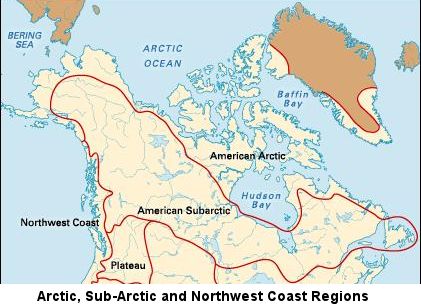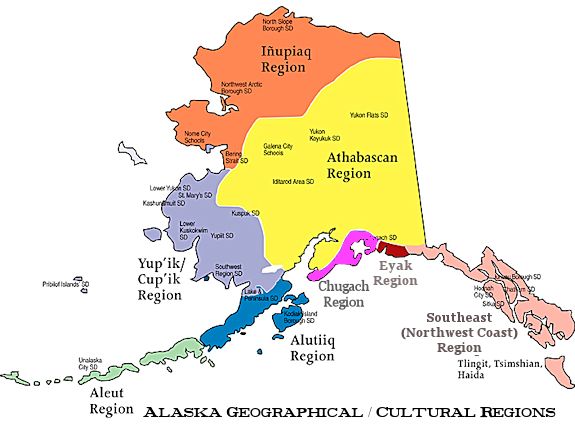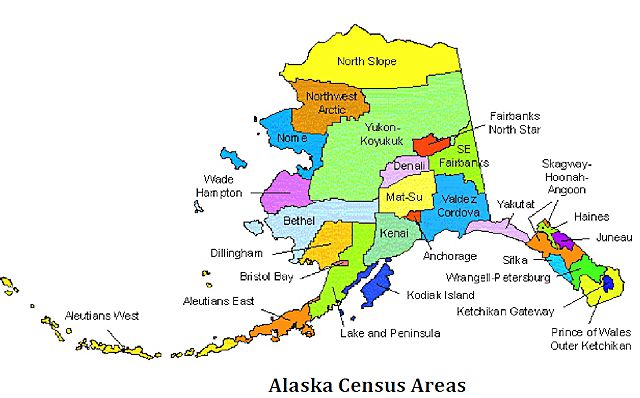Alaskan Geographical Regions
Alaska Native Geographical Regions
There are several ways that Alaskan geographical and culture regions are defined. There are three broad major geographical regions.

Arctic Region
The Arctic, or circumpolar, peoples are the indigenous inhabitants of the northernmost regions of the world. For the most part, they live beyond the climatic limits of agriculture, drawing a subsistence from hunting, trapping, and fishing or from pastoralism.
Thus climatic gradients rather than simple latitude determines the effective boundaries of the circumpolar region, and these gradients have their counterparts in the major environmental transitions. Of these transitions, the most important is the tree line, which marks the northern margin of the coniferous forest, or taiga.
The earliest inhabitants of North America's central and eastern Arctic are referred to as the Arctic small tool tradition (AST) and existed c. 2500 BC. It consisted of several Paleo-Eskimo cultures, including the Independence cultures and Pre-Dorset culture.
The Dorset culture (Inuktitut: Tuniit or Tunit) refers to the next inhabitants of central and eastern Arctic. The Dorset culture evolved because of technological and economic changes during the period of 1050–550 BC. With the exception of the Quebec/Labrador peninsula, the Dorset culture vanished around 1500 AD.
Supported by genetic testing, evidence shows that Dorset culture, known as the Sadlermiut, survived in Aivilik, Southampton and Coats Islands, until the beginning of the 20th century.
Dorset/Thule culture transition dates around the 9th–10th centuries. Scientists theorize that there may have been cross-contact of the two cultures with sharing of technology, such as fashioning harpoon heads, or the Thule may have found Dorset remnants and adapted their ways with the predecessor culture. Others believe the Thule displaced the Dorset.
By 1300, the Inuit, present-day Arctic inhabitants and descendants of Thule culture, had settled in west Greenland, and moved into east Greenland over the following century. Over time, the Inuit have migrated throughout the Arctic regions of Canada, Greenland, Russia and the United States.
Other Alaskan Native cultures still living in the Arctic Region include the Buryat, Chukchi, Evenks, Inupiat, Khanty, Koryaks, Nenets, Sami, Yukaghir, and Yupik, who still refer to themselves as Eskimo which means "snowshoe netters", not "raw meat eaters" as it is sometimes mistakenly translated.
Indigenous peoples of the Arctic include:
- Aleut (Unangan), Aleutian Islands of Alaska, and Kamchatka Krai, Russia
- Inuit (Eskimo), Eastern Siberia (Russia), Alaska (United States), Canada, Greenland (Denmark)
- Thule, proto-Inuit, Alaska, Canada, Greenland, 900–1500 CE
- Birnirk culture, prehistoric Inuit culture, Alaska, 500 CE–900 CE
- Greenlandic Inuit people, Greenland
- Kalaallit, west Greenland
- Avanersuarmiut (Inughuit), north Greenland
- Tunumiit, east Greenland
- Inuvialuit, western Canadian Arctic
- Iñupiat, north and northwest Alaska
- Thule, proto-Inuit, Alaska, Canada, Greenland, 900–1500 CE
- Yupik (Yup'ik and Cup'ik), Alaska and Russia
- Alutiiq people (Sugpiaq, Pacific Yupik), Alaska Peninsula, coastal and island areas of south central Alaska
- Central Alaskan Yup'ik people, west central Alaska
- Cup'ik, Hooper Bay and Chevak, Alaska
- Nunivak Cup'ig people (Cup'ig), Nunivak Island, Alaska
- Siberian Yupik people, Russian Far East and St. Lawrence Island, Alaska
- Chaplino
- Naukan
- Sirenik, Siberia
Sub-Arctic Region
The Sub-Arctic Region located south of the true Arctic. This region includes the interior of Alaska, the Western Subarctic or western Canadian Shield and Mackenzie River drainage area, and the Eastern Subarctic or Eastern Canadian Shield.
Peoples of subarctic Siberia and Greenland are sometimes included in the subarctic; however, Greenlandic Inuit are usually classified as Indigenous peoples of the Arctic.
Native subarctic peoples have over 30 languages, falling into two major language families: Algonquian and Athapaskan. Algonquian peoples tend to live in the east, while Athapaskan peoples live more in the west.
Indigenous people of the sub-arctic include:
- Ahtna (Ahtena, Nabesna)
- Anishinaabe
- Oji-Cree (Anishinini, Severn Ojibwa), Ontario, Manitoba
- Ojibwa (Chippewa, Ojibwe), Ontario, Manitoba, Minnesota
- Odawa (Ottawa)
- Atikamekw
- Bearlake
- Chipewyan
- Cree
- Dakelh
- Babine
- Wet'suwet'en
- Deg Hit’an (Deg Xinag, Degexit’an, Kaiyuhkhotana)
- Dena’ina (Dialects: Outer Inlet, Upper Inlet, Iliama, Inland, Kachemak Bay, Kenai, Susitna River)
- Dunneza (Beaver)
- Gwich'in (Kutchin, Loucheaux)
- Hän
- Hare
- Holikachuk
- Innu, Labrador and Quebec
- Montagnais
- Naskapi
- Kaska (Nahane)
- Kolchan (Upper Kuskokwim)
- Koyukon
- Mountain
- Naskapi
- Sekani
- Slavey (Dialects: Hay River, Simpson Providence, Liard, Fort Nelson)
- Tagish
- Tahltan
- Lower Tanana
- Middle Tanana
- Upper Tanana
- Tanacross
- Tasttine (Beaver)
- Tlicho
- Inland Tlingit
- Tsetsaut (extinct)
- Tsilhqot'in (Chilcotin)
- Northern Tutchone
- Southern Tutchone
- Yellowknives
Northwest Coast Region
The Northwest Coast Region includes three Alaskan tribes: the Haida, Tlingit, and Tsimshian.
Alaskan Natives live in seven geographical culture regions.

These regions are also commonly referred to by their Census Area designation, also called Boroughs.

Subcategories
Article Index:
The Aleut Culture Area includes the Aleutian Islands and the nearby Alaska Peninsula at the Southern edge of Alaska. The term “Aleut” was introduced by Russians and comes originally from the Koryak or Chukchi languages of Siberia. Aleut comes from the Russian word Aleuty.
Based in Sand Point, the Aleutians East Borough comprises the westernmost portion of the Alaska Peninsula, and a number of Aleutian islands.
The Aleutian Islands (possibly from Chukchi aliat, meaning “island”) are a chain of small islands situated in the Northern Pacific Ocean, and extending about 1,200 miles westward from the extremity of the Alaskan peninsula toward the peninsula of Kamchatka.
The Aleutians West Census Area has no borough seat. The census area has a total area of 36,562 km² (14,117 mi²). 11,388 km² (4,397 mi²) of it is land and 25,174 km² (9,720 mi²) of it is water. The total area is 68.85% water.
The people refer to themselves as Ungangan, and have been called “Aleut.” The Aleut language is related most closely to Eskimo languages.
